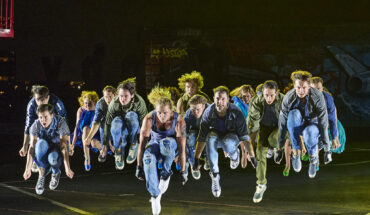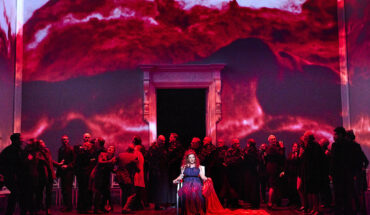When invited to attend the opening night of Opera Australia’s latest production, Bluebeard’s Castle, I knew to expect something different and interesting. Even without reading a summary of the story, “early 20th century Hungarian composer” already signals dark and dread. But this was next level. I’m talking serious psychological thriller stuff. Together with my plus one and the whole opening night audience, at curtain close I was shocked and impressed, visibly disturbed and wide awake. This is a piece of theatre that elicits an emotional reaction, inspires thought and stimulates conversation.
The plot is as follows. Judith has run away from her family and fiancé to be with Bluebeard, whom she vehemently declares to love. His castle, her new home, is deathly dark, with seven mysterious doors barred before her. Passionately insisting on bringing light and life in, Judith demands Bluebeard unlock the doors. The walls of the castle weep and moan in anguish. One by one each door opens to a horror more chilling than the one before: A torture chamber with bleeding walls, an armoury of bloodied weapons, a treasury of bloodstained jewels, a garden of white roses dripping with blood, a lake of tears, a vast kingdom of violence, and behind the seventh door, three captive former wives, faces hooded and hands tied.
Director Andy Morton and Associate Director Priscilla Jackman made the brilliant artistic decision to keep everything in this production pared back except Béla Bartók’s genius score, making the total effect intense, intimate and profoundly impactful. Any distracting details, unnecessary side stories, and secondary characters are eliminated. Minimal set pieces on a bleak stage, simple, symbolic costumes, and a cast of only two singing roles allow for a sharp incision into the depths of a dark, disturbed mind, a sick, secret life, and a bizarre, violent relationship. John Rayment’s dramatic lighting pierces starkly and casts deep shadows, effectively heightening the tension and blackening the mood.
Bartók’s music is oppressive and tense, full of dissonant tones and unresolved climaxes, mirroring the dissonance between husband and wife. The castle, bearing the burden of all it has witnessed, is embodied in the haunting, all-too frequent semitone trill of the blood motif. There is some expert use of percussion in this unique and interesting score, with the uber fast-played glockenspiel in particular lending momentum and a contrasting layer of height. The eerie oboes conjure dreamy, or rather nightmarish, emotions.
The vocal performances of both Daniel Sumegi as Blackbeard and Carmen Topciu as Judith are powerful and flawless. The fact that they have learned to sing in Hungarian is in and of itself an impressive feat. Sumegi being a bass-baritone and Topciu a mezzo-soprano lowers the register from the familiar tenor-soprano range of popular opera duets. This serves to weigh down the mood to the low sink of baseness of the eponymous villain. In fact, it is a good thing that the whole opera is over and done with in a single hour-long act, as any more of this heavy stuff would be too much to take. As it is, it is perfect.
By Alicia Tripp
Bluebeard’s Castle is showing at the Sydney Opera House until 10 March 2021
The venue is accessible
Purchase tickets now
Alicia was an invited guest of Opera Australia



